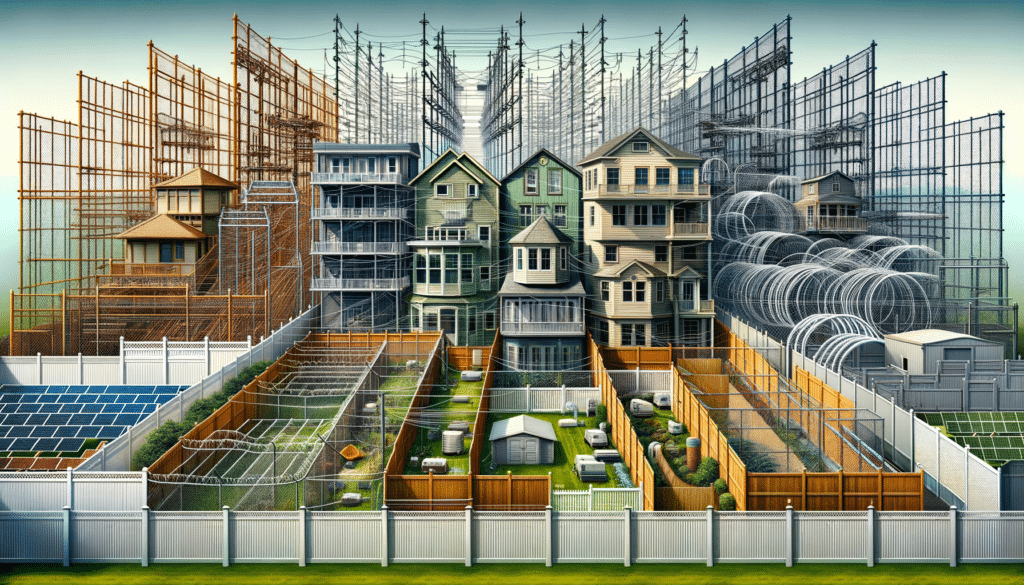Introduction to Fencing: More Than Just Boundaries
Fences have long been an integral part of human civilization, serving as more than just physical barriers. They define spaces, provide security, and offer privacy, all while enhancing the aesthetic appeal of properties. As we delve into the world of fencing, we’ll explore the various types available, understand the nuances of obtaining fence quotes, and recognize the signs that indicate when a fence replacement is necessary. Whether it’s a traditional wooden fence or a modern wired barrier, each type plays a crucial role in managing outdoor spaces effectively.
Types of Fences: Choosing the Right Barrier
When it comes to selecting a fence, the options are vast, each offering unique benefits and aesthetic appeal. Some of the most common types include:
- Wooden Fences: Known for their classic look, wooden fences are a popular choice for residential properties. They provide excellent privacy and can be customized in terms of height and style. However, they require regular maintenance to prevent rot and weather damage.
- Vinyl Fences: These are renowned for their durability and low maintenance. Vinyl fences resist weathering and do not require painting or sealing, making them a cost-effective long-term option.
- Chain Link Fences: Often used for security purposes, chain link fences are both durable and affordable. While they may not offer much privacy, they are effective in marking boundaries and keeping pets and children safe.
- Wrought Iron Fences: Known for their strength and ornate designs, wrought iron fences add a touch of elegance to properties. They are highly durable but can be prone to rust if not properly maintained.
- Aluminum Fences: Offering a similar look to wrought iron but at a lower cost, aluminum fences are lightweight and resistant to corrosion, making them suitable for various climates.
Each type of fence serves a specific purpose, and the choice often depends on factors such as budget, aesthetic preference, and the primary function of the fence.
Understanding Fence Quotes: What to Consider
Obtaining a fence quote is a crucial step in the installation process. It involves more than just comparing prices; it’s about understanding what each quote includes and ensuring it meets your specific needs. Here are some key considerations when evaluating fence quotes:
- Material Costs: Different materials come with varying costs. A detailed quote should break down the cost of materials, allowing you to compare the financial implications of choosing one type over another.
- Labor Charges: Installation costs can vary significantly depending on the complexity of the project and the expertise of the installers. Ensure the quote provides a clear explanation of labor charges.
- Additional Services: Some quotes may include additional services such as old fence removal, site preparation, or post-installation cleanup. It’s important to understand what is included to avoid unexpected expenses.
- Warranty and Maintenance: A comprehensive quote should outline any warranties offered and the recommended maintenance schedule to ensure the longevity of the fence.
By carefully reviewing fence quotes, you can make an informed decision that balances cost with quality and functionality.
Fence Replacement: Recognizing the Signs
Even the most durable fences have a lifespan, and recognizing when a replacement is necessary is crucial for maintaining the appearance and security of your property. Here are some common signs indicating it’s time for a fence replacement:
- Visible Damage: Cracks, holes, or warping in the material can compromise the fence’s structural integrity, making replacement a more viable option than repair.
- Leaning or Sagging: A fence that leans or sags may indicate foundational issues or rotting posts, both of which can necessitate a complete replacement.
- Excessive Repairs: If you’re frequently repairing sections of your fence, it may be more cost-effective to replace it entirely.
- Age: Over time, materials deteriorate. A fence that has reached the end of its expected lifespan will likely need replacement to ensure continued functionality.
Regular inspections can help identify these issues early, allowing for timely interventions and avoiding more significant problems down the line.
Conclusion: Making Informed Fencing Decisions
Fencing is a critical component of property management, offering security, privacy, and aesthetic value. By understanding the types of fences available, the intricacies of obtaining accurate fence quotes, and the signs that indicate a need for replacement, property owners can make informed decisions that enhance their outdoor spaces. Whether you’re considering a new installation or evaluating the condition of an existing fence, taking a thoughtful approach ensures that your fencing solution meets your needs both functionally and financially.


